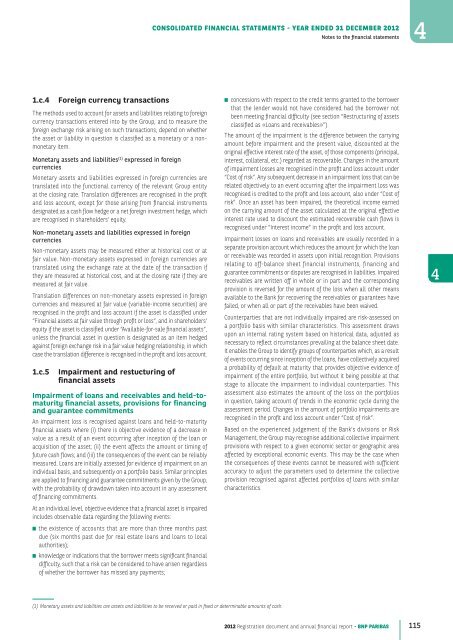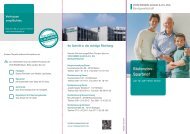2012 Registration document and annual financial report - BNP Paribas
2012 Registration document and annual financial report - BNP Paribas
2012 Registration document and annual financial report - BNP Paribas
- No tags were found...
You also want an ePaper? Increase the reach of your titles
YUMPU automatically turns print PDFs into web optimized ePapers that Google loves.
CONSOLIDATED FINANCIAL STATEMENTS - YEAR ENDED 31 DECEMBER <strong>2012</strong>Notes to the <strong>financial</strong> statements41.c.4Foreign currency transactionsThe methods used to account for assets <strong>and</strong> liabilities relating to foreigncurrency transactions entered into by the Group, <strong>and</strong> to measure theforeign exchange risk arising on such transactions, depend on whetherthe asset or liability in question is classified as a monetary or a nonmonetaryitem.Monetary assets <strong>and</strong> liabilities (1) expressed in foreigncurrenciesMonetary assets <strong>and</strong> liabilities expressed in foreign currencies aretranslated into the functional currency of the relevant Group entityat the closing rate. Translation differences are recognised in the profit<strong>and</strong> loss account, except for those arising from <strong>financial</strong> instrumentsdesignated as a cash flow hedge or a net foreign investment hedge, whichare recognised in shareholders’ equity.Non-monetary assets <strong>and</strong> liabilities expressed in foreigncurrenciesNon-monetary assets may be measured either at historical cost or atfair value. Non-monetary assets expressed in foreign currencies aretranslated using the exchange rate at the date of the transaction ifthey are measured at historical cost, <strong>and</strong> at the closing rate if they aremeasured at fair value.Translation differences on non-monetary assets expressed in foreigncurrencies <strong>and</strong> measured at fair value (variable-income securities) arerecognised in the profit <strong>and</strong> loss account if the asset is classified under“Financial assets at fair value through profit or loss”, <strong>and</strong> in shareholders’equity if the asset is classified under “Available-for-sale <strong>financial</strong> assets”,unless the <strong>financial</strong> asset in question is designated as an item hedgedagainst foreign exchange risk in a fair value hedging relationship, in whichcase the translation difference is recognised in the profit <strong>and</strong> loss account.1.c.5Impairment <strong>and</strong> restucturing of<strong>financial</strong> assetsImpairment of loans <strong>and</strong> receivables <strong>and</strong> held-tomaturity<strong>financial</strong> assets, provisions for financing<strong>and</strong> guarantee commitmentsAn impairment loss is recognised against loans <strong>and</strong> held-to-maturity<strong>financial</strong> assets where (i) there is objective evidence of a decrease invalue as a result of an event occurring after inception of the loan oracquisition of the asset; (ii) the event affects the amount or timing offuture cash flows; <strong>and</strong> (iii) the consequences of the event can be reliablymeasured. Loans are initially assessed for evidence of impairment on anindividual basis, <strong>and</strong> subsequently on a portfolio basis. Similar principlesare applied to financing <strong>and</strong> guarantee commitments given by the Group,with the probability of drawdown taken into account in any assessmentof financing commitments.At an individual level, objective evidence that a <strong>financial</strong> asset is impairedincludes observable data regarding the following events:■ the existence of accounts that are more than three months pastdue (six months past due for real estate loans <strong>and</strong> loans to localauthorities);■ knowledge or indications that the borrower meets significant <strong>financial</strong>difficulty, such that a risk can be considered to have arisen regardlessof whether the borrower has missed any payments;■ concessions with respect to the credit terms granted to the borrowerthat the lender would not have considered had the borrower notbeen meeting <strong>financial</strong> difficulty (see section “Restructuring of assetsclassified as «L oans <strong>and</strong> receivables»”).The amount of the impairment is the difference between the carryingamount before impairment <strong>and</strong> the present value, discounted at theoriginal effective interest rate of the asset, of those components (principal,interest, collateral, etc.) regarded as recoverable. Changes in the amountof impairment losses are recognised in the profit <strong>and</strong> loss account under“Cost of risk”. Any subsequent decrease in an impairment loss that can berelated objectively to an event occurring after the impairment loss wasrecognised is credited to the profit <strong>and</strong> loss account, also under “Cost ofrisk”. Once an asset has been impaired, the theoretical income earnedon the carrying amount of the asset calculated at the original effectiveinterest rate used to discount the estimated recoverable cash flows isrecognised under “Interest income” in the profit <strong>and</strong> loss account.Impairment losses on loans <strong>and</strong> receivables are usually recorded in aseparate provision account which reduces the amount for which the loanor receivable was recorded in assets upon initial recognition. Provisionsrelating to off-balance sheet <strong>financial</strong> instruments, financing <strong>and</strong>guarantee commitments or disputes are recognised in liabilities. Impairedreceivables are written off in whole or in part <strong>and</strong> the correspondingprovision is reversed for the amount of the loss when all other meansavailable to the Bank for recovering the receivables or guarantees havefailed, or when all or part of the receivables have been waived.Counterparties that are not individually impaired are risk-assessed ona portfolio basis with similar characteristics. This assessment drawsupon an internal rating system based on historical data, adjusted asnecessary to reflect circumstances prevailing at the balance sheet date.It enables the Group to identify groups of counterparties which, as a resultof events occurring since inception of the loans, have collectively acquireda probability of default at maturity that provides objective evidence ofimpairment of the entire portfolio, but without it being possible at thatstage to allocate the impairment to individual counterparties. Thisassessment also estimates the amount of the loss on the portfoliosin question, taking account of trends in the economic cycle during theassessment period. Changes in the amount of portfolio impairments arerecognised in the profit <strong>and</strong> loss account under “Cost of risk”.Based on the experienced judgement of the Bank’s divisions or RiskManagement, the Group may recognise additional collective impairmentprovisions with respect to a given economic sector or geographic areaaffected by exceptional economic events. This may be the case whenthe consequences of these events cannot be measured with sufficientaccuracy to adjust the parameters used to determine the collectiveprovision recognised against affected portfolios of loans with similarcharacteristics.4(1) Monetary assets <strong>and</strong> liabilities are assets <strong>and</strong> liabilities to be received or paid in fixed or determinable amounts of cash.<strong>2012</strong> <strong>Registration</strong> <strong>document</strong> <strong>and</strong> <strong>annual</strong> <strong>financial</strong> <strong>report</strong> - <strong>BNP</strong> PARIBAS 115





